These notes are intended to provide a casual sky watcher or someone already into amateur astronomy living in Eastern Australia with a summary of what is happening in the night sky in October 2013. The finder charts have been produced for an observer based on the Gold Coast (Queensland, Australia) but will be useful for observers elsewhere in Eastern Australia. Instructions on how to obtain customised satellite viewing information for your location can be found here. If you find this page of interest, you may wish to follow this website automatically using Twitter and the sites RSS Feed.
Planets for October 2013
All planet comments are for mid-October 2013 unless otherwise noted.
Venus is visible high above the Western horizon as evening twilight ends. Saturn begins October visible to the eye low above the Western horizon as evening twilight ends. However, Earth’s speedier movement in our orbit around the Sun means that we are well and truly leaving Saturn behind. This means from our viewpoint that by the end of the month Saturn will be ost in the glare of evening twilight. Mercury reaches maximum elongation from the Sun on 9 October and will be best placed for observation in the first half of the month. In the second half of October 2013, Mercury will move back towards the glare of the Sun and be lost from view. Saturn and Mercury will reappear in the morning sky in November. Mars rises at 2:45 am AEST mid-month for the Brisbane / Gold Coast / Northern Rivers region. Jupiter rises at 12:25 am AEST mid-month for the Brisbane / Gold Coast / Northern Rivers region. Both Mars and Jupiter are visible low above the North Eastern horizon as morning twilight begins. Neptune is visible all month in the evening sky and sets around 3 am mid month. Uranus is visible almost all night due to it having reached opposition on 3 October 2013.
Note that to the unaided eye all planets look like stars. This explains how they were given their name. The word planet originally derives from an ancient Greek word ἀστὴρ πλανήτης (astēr planētēs) which means ‘wandering star’. Mercury, Venus, Mars, Saturn and Jupiter are easily visible to the unaided eye.
Due to their faintness, Uranus and Neptune will require a minimum of large pair of binoculars and a detailed finder chart to locate (see http://www.skyandtelescope.com/observing/objects/planets/12435011.html).
Individual Sky Events for October 2013
All times AEST unless otherwise stated. Add one hour if your state or territory follows ‘Summer Time’.
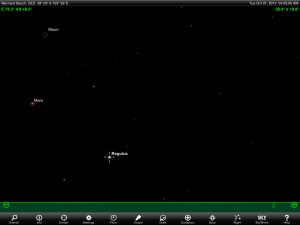
1 October 2013: Waning crescent Moon located above Mars. Morning pre-dawn sky.
3 October 2013: Venus at aphelion
3 October 2013: Midnight. Uranus at opposition.
4 October 2013: Jupiter 0.1 degree South of Delta Geminorum. Morning sky.
5 October 2013: 10:35 am New Moon
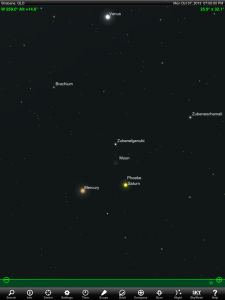
7 October 2013: Slim crescent Moon, Mercury and Saturn form a temporary triangle low above the Western horizon as evening twilight ends.
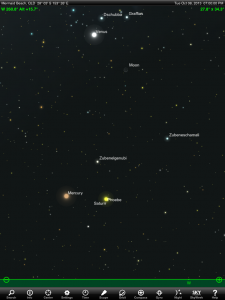
8 October 2013: Slim crescent Moon located below and to the right of Venus. Early evening sky.
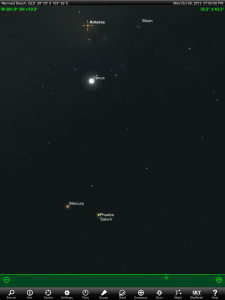
9 October 2013: Crescent Moon located above and to the right of Venus. Early evening sky.
9 October 2013: 8 pm Mercury at greatest elongation East (25.3 degrees)
11 October 2013: 9 am Moon at perigee (369,814 km from Earth in its orbit)
12 October 2013: 9.02 am First Quarter Moon
15 October 2013: Mercury at greatest latitude South
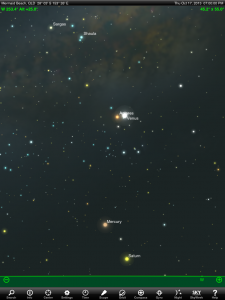
19 October 2013: 9:38 am Full Moon
19 October 2013: Penumbral Lunar Eclipse. Not visible from Australia.
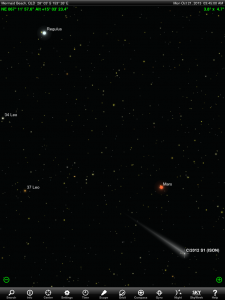
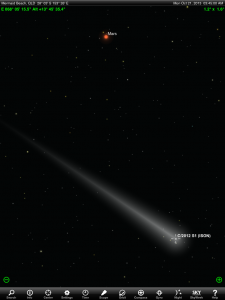
21 October 2013: If you have a medium to large telescope, you might want to look for Comet 2012 S1 ISON in the morning pre-dawn sky. Keep in mind that the comet is faint (Magnitude +9.3 according to Sky Safari Pro). For this reason, I have shown stars to magnitude +10 to allow you to star hop to the comets position. Also the bright Moon present will dramatically affect the appearance of Comet 2012 S1 ISON. Observers in the Southern hemisphere will have their best view of the comet next month.
21 October 2013: Orionid Meteor Shower peaks. The brightness of the Moon will prevent all but the brightest meteors from being visible.
22 October 2013: 1 am Mercury stationary
23 October 2013: 9 pm minor planet 387 Aquitania 0.05 degrees North West of 60 Sagittarii. Aquintania is faint at only magnitude +11.8 requiring a large amateur telescope to glimpse it.
25 October 2013: Venus at greatest latitude South
25 October 2013: Midnight Moon at apogee (404,557 km from Earth in it’s orbit)
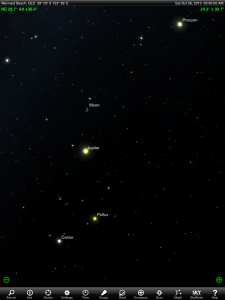
26 October 2013: Waning gibbous Moon located above Jupiter. Morning sky.
27 October 2013: 9:40 am Last Quarter Moon
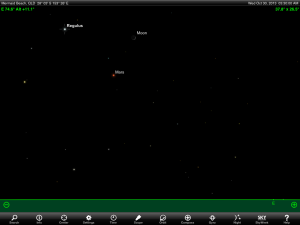
30 October 2013: Waning crescent Moon located above Mars. Morning pre-dawn sky.
For Further Information
Customised Astronomy & Satellite Viewing information
Information on how to obtain customised astronomy & satellite viewing information for your location can be found here on this website.
Information About The Finder Charts
Charts accompanying this article have been produced with permission using the highly recommended Sky Safari Pro tablet app. Stars are shown to 5th magnitude. This is a compromise between what would be seen from a dark sky site and the reality that most people live in cities or towns with significant light pollution.
References
The information in this post has been prepared using the following references.
- Astronomy 2013, Quasar Publishing http://www.quasarastronomy.
com.au/ - Sky Safari Pro Ipad app, http://www.southernstars.com/
products/skysafari/index.html - https://en.wikipedia.org/wiki/Planet
hello my name is joshua and this sounds pretty cool
this is awsome tanks for that
No Comet ISON?
Fantastic! Thanks 🙂